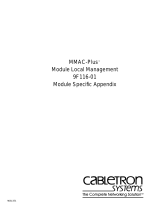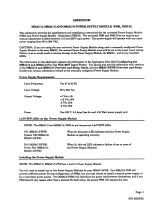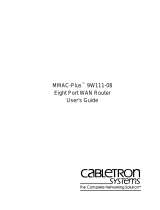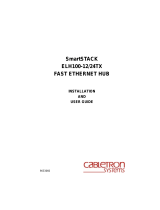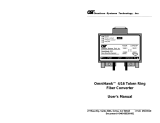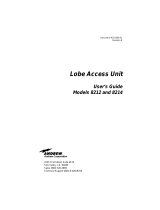Page is loading ...

TRBMIM-T
TOKEN RING BRIDGE/MANAGEMENT MODULE
USER’S GUIDE
BOOKTITLE2 OPTIONAL
TRBMIM-T BOOK Page 1 Tuesday, July 2, 1996 10:35 AM

TRBMIM-T BOOK Page 2 Tuesday, July 2, 1996 10:35 AM

i
NOTICE
Cabletron Systems reserves the right to make changes in specifications and other information
contained in this document without prior notice. The reader should in all cases consult Cabletron
Systems to determine whether any such changes have been made.
The hardware, firmware, or software described in this manual is subject to change without notice.
IN NO EVENT SHALL CABLETRON SYSTEMS BE LIABLE FOR ANY INCIDENTAL,
INDIRECT, SPECIAL, OR CONSEQUENTIAL DAMAGES WHATSOEVER (INCLUDING BUT
NOT LIMITED TO LOST PROFITS) ARISING OUT OF OR RELATED TO THIS MANUAL OR
THE INFORMATION CONTAINED IN IT, EVEN IF CABLETRON SYSTEMS HAS BEEN
ADVISED OF, KNOWN, OR SHOULD HAVE KNOWN, THE POSSIBILITY OF SUCH
DAMAGES.
Copyright 1996 by Cabletron Systems, Inc., P.O. Box 5005, Rochester, NH 03866-5005
All Rights Reserved
Printed in the United States of America
Order Number: 9031496-01 July 1996
EMME
,
EMM-E6
,
SPECTRUM
,
TRMM
,
TRMMIM
,
TRBMIM,
and
TRBMIM-T
are registered
trademarks, and
TPIM
is a trademark of Cabletron Systems, Inc.
All other product names mentioned in this manual may be trademarks or registered trademarks of
their respective companies.
Printed on Recycled Paper
TRBMIM-T BOOK Page i Tuesday, July 2, 1996 10:35 AM

NOTICE
ii
FCC NOTICE
This device complies with Part 15 of the FCC rules. Operation is subject to the following two
conditions: (1) this device may not cause harmful interference, and (2) this device must accept any
interference received, including interference that may cause undesired operation.
NOTE:
This equipment has been tested and found to comply with the limits for a Class A digital
device, pursuant to Part 15 of the FCC rules. These limits are designed to provide reasonable
protection against harmful interference when the equipment is operated in a commercial environment.
This equipment uses, generates, and can radiate radio frequency energy and if not installed in
accordance with the operator’s manual, may cause harmful interference to radio communications.
Operation of this equipment in a residential area is likely to cause interference in which case the user
will be required to correct the interference at his own expense.
WARNING:
Changes or modifications made to this device which are not expressly approved by the
party responsible for compliance could void the user’s authority to operate the equipment.
DOC NOTICE
This digital apparatus does not exceed the Class A limits for radio noise emissions from digital
apparatus set out in the Radio Interference Regulations of the Canadian Department of
Communications.
Le présent appareil numérique n’émet pas de bruits radioélectriques dépassant les limites applicables
aux appareils numériques de la class A prescrites dans le Règlement sur le brouillage radioélectrique
édicté par le ministère des Communications du Canada.
VCCI NOTICE
This equipment is in the 1st Class Category (information equipment to be used in commercial and/or
industrial areas) and conforms to the standards set by the Voluntary Control Council for Interference
by Information Technology Equipment (VCCI) aimed at preventing radio interference in commercial
and/or industrial areas.
Consequently, when used in a residential area or in an adjacent area thereto, radio interference may be
caused to radios and TV receivers, etc.
Read the instructions for correct handling.
TRBMIM-T BOOK Page ii Tuesday, July 2, 1996 10:35 AM

NOTICE
iii
CABLETRON SYSTEMS, INC. PROGRAM LICENSE AGREEMENT
IMPORTANT:
Before utilizing this product, carefully read this License Agreement.
This document is an agreement between you, the end user, and Cabletron Systems, Inc. (“Cabletron”)
that sets forth your rights and obligations with respect to the Cabletron software program (the
“Program”) contained in this package. The Program may be contained in firmware, chips or other
media. BY UTILIZING THE ENCLOSED PRODUCT, YOU ARE AGREEING TO BECOME
BOUND BY THE TERMS OF THIS AGREEMENT, WHICH INCLUDES THE LICENSE AND
THE LIMITATION OF WARRANTY AND DISCLAIMER OF LIABILITY. IF YOU DO NOT
AGREE TO THE TERMS OF THIS AGREEMENT, PROMPTLY RETURN THE UNUSED
PRODUCT TO THE PLACE OF PURCHASE FOR A FULL REFUND.
CABLETRON SOFTWARE PROGRAM LICENSE
1. LICENSE
. You have the right to use only the one (1) copy of the Program provided in this
package subject to the terms and conditions of this License Agreement.
You may not copy, reproduce or transmit any part of the Program except as permitted by the
Copyright Act of the United States or as authorized in writing by Cabletron.
2. OTHER RESTRICTIONS. You may not reverse engineer, decompile, or disassemble the
Program.
3. APPLICABLE LAW. This License Agreement shall be interpreted and governed under the laws
and in the state and federal courts of New Hampshire. You accept the personal jurisdiction and
venue of the New Hampshire courts.
EXCLUSION OF WARRANTY AND DISCLAIMER OF LIABILITY
1. EXCLUSION OF
WARRANTY. Except as may be specifically provided by Cabletron in
writing, Cabletron makes no warranty, expressed or implied, concerning the Program (including
its documentation and media).
CABLETRON DISCLAIMS ALL WARRANTIES, OTHER THAN THOSE SUPPLIED TO
YOU BY CABLETRON IN WRITING, EITHER EXPRESSED OR IMPLIED, INCLUDING
BUT NOT LIMITED TO IMPLIED WARRANTIES OF MERCHANTABILITY AND
FITNESS FOR A PARTICULAR PURPOSE, WITH RESPECT TO THE PROGRAM, THE
ACCOMPANYING WRITTEN MATERIALS, AND ANY ACCOMPANYING HARDWARE.
2. NO LIABILITY FOR CONSEQUENTIAL DAMAGES. IN NO EVENT SHALL
CABLETRON OR ITS SUPPLIERS BE LIABLE FOR ANY DAMAGES WHATSOEVER
(INCLUDING, WITHOUT LIMITATION, DAMAGES FOR LOSS OF BUSINESS,
PROFITS, BUSINESS INTERRUPTION, LOSS OF BUSINESS INFORMATION, SPECIAL,
INCIDENTAL, CONSEQUENTIAL, OR RELIANCE DAMAGES, OR OTHER LOSS)
ARISING OUT OF THE USE OR INABILITY TO USE THIS CABLETRON PRODUCT,
EVEN IF CABLETRON HAS BEEN ADVISED OF THE POSSIBILITY OF SUCH
DAMAGES. BECAUSE SOME STATES DO NOT ALLOW THE EXCLUSION OR
LIMITATION OF LIABILITY FOR CONSEQUENTIAL OR INCIDENTAL DAMAGES, OR
ON THE DURATION OR LIMITATION OF IMPLIED WARRANTIES, IN SOME
INSTANCES THE ABOVE LIMITATIONS AND EXCLUSIONS MAY NOT APPLY TO
YOU.
TRBMIM-T BOOK Page iii Tuesday, July 2, 1996 10:35 AM

NOTICE
iv
UNITED STATES GOVERNMENT RESTRICTED RIGHTS
The enclosed product (a) was developed solely at private expense; (b) contains “restricted computer
software” submitted with restricted rights in accordance with Section 52227-19 (a) through (d) of the
Commercial Computer Software - Restricted Rights Clause and its successors, and (c) in all respects
is proprietary data belonging to Cabletron and/or its suppliers.
For Department of Defense units, the product is licensed with “Restricted Rights” as defined in the
DoD Supplement to the Federal Acquisition Regulations, Section 52.227-7013 (c) (1) (ii) and its
successors, and use, duplication, disclosure by the Government is subject to restrictions as set forth in
subparagraph (c) (1) (ii) of the Rights in Technical Data and Computer Software clause at 252.227-
7013. Cabletron Systems, Inc., 35 Industrial Way, Rochester, New Hampshire 03867-0505.
TRBMIM-T BOOK Page iv Tuesday, July 2, 1996 10:35 AM

NOTICE
v
DECLARATION OF CONFORMITY
Application of Council Directive(s):
89/336/EEC
73/23/EEC
Manufacturer’s Name:
Cabletron Systems, Inc.
Manufacturer’s Address:
35 Industrial Way
PO Box 5005
Rochester, NH 03867
European Representative Name:
Mr. J. Solari
European Representative Address:
Cabletron Systems Limited
Nexus House, Newbury Business Park
London Road, Newbury
Berkshire RG13 2PZ, England
Conformance to Directive(s)/Product Standards:
EC Directive 89/336/EEC
EC Directive 73/23/EEC
EN 55022
EN 50082-1
EN 60950
Equipment Type/Environment:
Networking Equipment, for use in a Commercial or Light
Industrial Environment.
We the undersigned, hereby declare that the equipment packaged with this notice conforms to the
above directives.
Manufacturer Legal Representative in Europe
Mr. Richard Michaud Mr. J. Solari
___________________________________ ___________________________________
Full Name Full Name
Manager of Engineering Services Managing Director - E.M.E.A.
___________________________________ ___________________________________
Title Title
Rochester, NH, USA Newbury, Berkshire, England
___________________________________ ___________________________________
Location Location
TRBMIM-T BOOK Page v Tuesday, July 2, 1996 10:35 AM

NOTICE
vi
TRBMIM-T BOOK Page vi Tuesday, July 2, 1996 10:35 AM

vii
CONTENTS
CHAPTER 1 INTRODUCTION
1.1 Document Conventions...............................................................1-2
1.2 Getting Help.................................................................................1-2
1.3 Using This Manual.......................................................................1-3
1.4 TRBMIM-T Overview...................................................................1-4
1.4.1 Describing Bridge-Only Mode Capabilities .....................1-6
1.4.2 Describing Bridge/Management Mode Capabilities........1-8
1.4.3 Monitoring And Troubleshooting Systems....................1-10
1.4.4 System Safeguards ......................................................1-11
1.4.5 Management Access ....................................................1-11
1.4.6 IP Address Auto-Configuration .....................................1-13
1.5 Source-Route Bridging Overview..............................................1-13
1.6 Related Manuals........................................................................1-14
1.7 Recommended Reading............................................................1-15
CHAPTER 2 REQUIREMENTS AND SPECIFICATIONS
2.1 MMAC Requirements..................................................................2-1
2.2 Installation Requirements............................................................2-1
2.3 Bridge/Management Mode Requirements...................................2-2
2.4 Front-Panel Components ............................................................2-2
2.4.1 Port Specifications..........................................................2-3
2.4.2 LANVIEW LEDs..............................................................2-5
2.4.3 Using The Reset Button..................................................2-6
2.5 Configuring The TRBMIM-T ........................................................2-6
2.5.1 Dip Switch Settings.........................................................2-7
2.5.2 Jumper Settings..............................................................2-9
2.6 General Specifications...............................................................2-10
2.6.1 Safety............................................................................2-10
2.6.2 Electromagnetic Compatibility (EMC)...........................2-10
2.6.3 Port Specifications........................................................2-10
2.6.4 Physical Specifications .................................................2-10
2.6.5 Environmental Specifications........................................2-11
CHAPTER 3 INSTALLATION
3.1 Unpacking And Handling The TRBMIM-T...................................3-1
3.2 Installing The TRBMIM-T.............................................................3-1
TRBMIM-T BOOK Page vii Tuesday, July 2, 1996 10:35 AM

CONTENTS
viii
CHAPTER 4 ESTABLISHING THE BRIDGE CONNECTION
4.1 Setting Up The Station Port.........................................................4-1
4.1.1 Configuring TPIMs...........................................................4-1
4.1.2 Installing A TPIM.............................................................4-3
4.2 Connecting Twisted Pair Cable....................................................4-4
4.3 Connecting Fiber Optic Cable......................................................4-6
CHAPTER 5 MONITORING AND TROUBLESHOOTING
5.1 Describing LEDs ..........................................................................5-1
5.1.1 Describing System LEDs.................................................5-2
5.1.2 Describing FNB LEDs .....................................................5-3
5.1.3 Describing STN LEDs .....................................................5-5
5.2 Monitoring The Initialization Process ...........................................5-6
5.2.1 Monitoring With The Power Up Diagnostic Screen.........5-6
5.2.2 Monitoring With LEDs......................................................5-8
5.3 Troubleshooting Checklist............................................................5-8
5.3.1 Checking The TRBMIM-T................................................5-8
5.3.2 Checking The Entire Ring .............................................5-10
APPENDIX A TPIM SPECIFICATIONS
A.1 TPIM-T1/T2/T4 Pinouts............................................................... A-1
A.2 TPIM-F2/F3 Specifications.......................................................... A-2
APPENDIX B MEDIA SPECIFICATIONS
B.1 Unshielded Twisted Pair (UTP)................................................... B-1
B.2 Shielded Twisted Pair (STP).......................................................B-2
B.3 Fiber Optic ..................................................................................B-3
INDEX
TRBMIM-T BOOK Page viii Tuesday, July 2, 1996 10:35 AM

1-1
CHAPTER 1
INTRODUCTION
Welcome to the
TRBMIM-T Token Ring Bridge/Management Module
User’s Guide
. This manual describes TRBMIM-T (see Figure 1-1)
capabilities and features, operating specifications, and configuration,
installation, and troubleshooting procedures. Users of the TRBMIM-T
should have a basic working knowledge of the IEEE 802.5 standard for
Token Ring networks, Token Ring network physical components, and
source-route bridging concepts.
Figure 1-1 Token Ring Bridge/Management Module
TRBMIM-T
SN
16 Mb
BOK
NSRT
LWRP
ERR
RESET
F
N
B
16 Mb
RWRP
S
T
N
WFLT
WRP
STBY
TOKEN RING BRIDGE
S
T
I
A
T
O
N
T
M
I
P
C
S
N
O
L
E
O
TPIM-T1
LNK
TRBMIM-T BOOK Page 1 Tuesday, July 2, 1996 10:35 AM

INTRODUCTION
1-2
1.1 DOCUMENT CONVENTIONS
The following conventions are used throughout this document:
Bold Italics
for references to Cabletron Systems documents and other
publications
1.2 GETTING HELP
If you need assistance installing or using the TRBMIM-T, or if you have
any questions, comments, or suggestions concerning this manual, contact
Cabletron Systems Technical Support:
By phone (603) 332-9400
Monday-Friday; 8 a.m. – 8 p.m. Eastern Time
By CompuServe GO CTRON from any ! prompt
By Internet mail [email protected]
By FTP ctron.com or 134.141.197.25
Login
anonymous
Password
your email address
NOTE
Note provides information of special importance.
!
CAUTION
Caution provides information about potential hazards to
equipment, including hardware, software, and
network-configuration settings.
Hazard provides information about potential shock hazards.
The bridge symbol is used in illustrations to indicate bridged
Token Rings.
TRBMIM-T BOOK Page 2 Tuesday, July 2, 1996 10:35 AM

INTRODUCTION
1-3
1.3 USING THIS MANUAL
The manual is organized as follows:
Chapter 1,
Introduction
, describes this manual’s conventions and
organizational structure, how to get technical help, TRBMIM-T features
and capabilities, source-route bridging concepts, and related reading and
reference sources.
Chapter 2,
Requirements and Specifications
, describes operational
requirements and specifications, including MMAC and management
module requirements, port specifications, and instructions for establishing
operational parameters using dip switches and shunting jumpers on the
component board.
Chapter 3,
Installation
, describes how to install the TRBMIM-T into an
MMAC.
Chapter 4,
Establishing the Bridge Connection
, describes how to setup
the front-panel bridge Station port and establish the physical bridge
connection between Token Rings.
Chapter 5,
Monitoring and Troubleshooting
, describes TRBMIM-T
monitoring and diagnostic tools: LANVIEW LEDs and the Power Up
Diagnostic screen. It also describes basic troubleshooting procedures.
Appendix A,
TPIM Specifications
, describes TPIM operational
specifications.
Appendix B,
Media Specifications
, describes design and performance
specifications for each of the media types used with the TRBMIM-T.
TRBMIM-T BOOK Page 3 Tuesday, July 2, 1996 10:35 AM

INTRODUCTION
1-4
1.4 TRBMIM-T OVERVIEW
The TRBMIM-T is two-port source-route bridge with management
capabilities. The two TRBMIM-T bridge ports are described as follows:
• The FNB backplane connector on the TRBMIM-T component board
interfaces with the FNB ring in the MMAC.
• The media-configurable Station port on the front panel interfaces with
another ring
via cable connection
to any lobe port on another ring,
regardless of whether the other ring is configured in the same MMAC
where the TRBMIM-T is installed or supported by another MMAC or
standalone hub. See Chapter 4 for information on how to set up the
bridge Station port and establish the physical bridge connection
between rings.
You can configure the TRBMIM-T to operate either as a dedicated
source-route bridge for linking Token Ring networks or as a combination
bridge and ring management module for both bridging and ring
management. It installs into any of the Media Interface Module (MIM)
slots of the following Cabletron Systems line of Multi Media Access
Centers:
• MMAC-M3FNB/-3FNB
• MMAC-M5FNB/-5FNB
• MMAC-M8FNB/-8FNB
See Chapter 2 for more information about MMAC requirements.
TRBMIM-T Features
TRBMIM-T features include:
• IBM Token Ring Network and source-route bridge compatibility
• IBM LAN NET Manager support
• SNMP-compliant in-band management support for remote
management applications
TRBMIM-T BOOK Page 4 Tuesday, July 2, 1996 10:35 AM

INTRODUCTION
1-5
• Local Management (LM) applications, accessible via:
- Out-of-band connection to the front-panel RS-232 Console port to
a VT-series terminal or a PC running a VT-series emulation
program
- In-band Telnet connection from any TCP/IP - based node linked to
the TRBMIM-T
• Selectable operating modes:
- Bridge/Management for bridging and ring management
- Bridge-Only for dedicated high-performance source-route
bridging
• Selectable Token Ring operating speeds of 4 Mbps and 16 Mbps for
the FNB port and the bridge Station port
• Media-flexibility for the front-panel bridge Station port provided by
interchangeable, hot-swappable Cabletron Systems Token Ring Port
Interface Modules (TPIMs)
• Flash EPROM firmware enhancement capability via Trivial File
Transfer Protocol (TFTP)
• LANVIEW LED system monitoring and diagnostics system
• Boot PROM support for IP Auto-Configuration from a BootP server
• Automatic Beacon Recovery Process (ABRP) restores network
functioning from beaconing conditions caused by hard errors detected
on the ring
• 24-MHz, 32-bit Intel i960 processor
• Battery-backed Non-Volatile RAM (NVRAM) for preserving data and
system configuration settings
• Thermal sensors that detect overheating in the MMAC
TRBMIM-T BOOK Page 5 Tuesday, July 2, 1996 10:35 AM

INTRODUCTION
1-6
1.4.1 Describing Bridge-Only Mode Capabilities
The Bridge-Only mode is the default operational mode for the
TRBMIM-T. When in the Bridge-Only mode, the TRBMIM-T serves
exclusively as a source-route bridge in the MMAC for linking separate
Token Rings. It neither automatically segments the FNB backplane nor
performs any of the ring-management functions available when operating
in the optional dual-function Bridge/Management mode.
Bridging Token Rings In The Same MMAC
Figure 1-2 illustrates how the TRBMIM-T can be used to bridge Ring 1
and Ring 2 in the same MMAC. In this configuration the TRBMIM-T’s
FNB port is connected to Ring 2. Its front-panel bridge Station port is
connected to Ring 1 via cable to any lobe port on any MIM on Ring 1.
The TRMMIM is managing Ring 2.
Figure 1-2 Bridging Token Rings in the Same MMAC
NOTE
The ring identifiers, Ring 1 and Ring 2, in the following
examples are used for illustrative purposes only. They are not
intended to reflect or recommend an actual ring numbering
scheme. See the
TRBMIM/TRBMIM-T Local Management
User’s Guide
for information on FNB and Station port ring
numbers.
TRMM
MIM
MIM
MIM
TRBMIM-T
MIM
MIM
TRMMIM
Bisected MMAC FNB Backplane
Ring Managed By TRMMRing Managed By TRMMIM
Ring 1Ring 2
TRBMIM-T BOOK Page 6 Tuesday, July 2, 1996 10:35 AM

INTRODUCTION
1-7
Bridging Token Rings In Separate MMACs
Figure 1-3 illustrates how the TRBMIM-T can be used to bridge Ring 1 in
one MMAC and Ring 2 in another MMAC. In this configuration the
TRBMIM-T’s FNB port is connected to Ring 1. Its front-panel bridge
Station port is connected to Ring 2 via cable to any lobe port on any MIM
on Ring 2.
Figure 1-3 Bridging Token Rings in Separate MMACs
TRMM
MIM
MIM
MIM
MIM
MIM
MIM
TRBMIM-T
TRMM
MIM
MIM
MIM
MIM
MIM
MIM
MIM
Ring 1
Ring 2
TRBMIM-T BOOK Page 7 Tuesday, July 2, 1996 10:35 AM

INTRODUCTION
1-8
Collapsed Backbone Configuration
Figure 1-4 illustrates how multiple TRBMIM-Ts can be used in the
MMAC to constitute a single collapsed backbone ring to provide network
connectivity for multiple rings, running at either 4 Mbps or 16 Mbps ring
speeds and linked to the backbone via either twisted pair copper or fiber
media. In this configuration each TRBMIM-T’s FNB port is connected to
a common FNB ring in the MMAC. Each TRBMIM-T’s front-panel
bridge Station port is connected to a separate ring via cable to any lobe
port on any MIM on each ring.
Figure 1-4 Collapsed Backbone Ring
1.4.2 Describing Bridge/Management Mode Capabilities
This section describes the optional functionality provided by the
TRBMIM-T when configured to operate in the combination
Bridge/Management mode. You can use the TRBMIM-T in the
Bridge/Management mode when you want to establish an additional
Token Ring in the MMAC that already supports either an Ethernet or a
Token Ring LAN. See Section 2.3 for Bridge/Management mode
requirements.
TRBMIM-T
TRBMIM-T
TRBMIM-T
TRBMIM-T
TRMM
TRBMIM-T
TRBMIM-T
TRBMIM-T
FNB Ring
16 Mbps
16 Mbps
16 Mbps
4 Mbps
16 Mbps
4 Mbps
16 Mbps
16 Mbps
Fiber
Twisted Pair
TRBMIM-T BOOK Page 8 Tuesday, July 2, 1996 10:35 AM

INTRODUCTION
1-9
Management Functionality In The MMAC
When configured for operation as a combination Bridge/Management
module and installed in any MIM slot in the MMAC, the TRBMIM-T
automatically bisects the FNB backplane. This creates a new FNB ring,
supporting Token Ring stations connected to the media interface modules
inserted to the left of the TRBMIM-T.
The TRBMIM-T manages the new ring in conjunction with the
master-management module (Ethernet or Token Ring) installed in the
MMAC management slot. Token Ring management module functions
include:
• Collecting ring statistics
• Supporting in-band and out-of-band network management
• Sending traps and alarms to Network Management Stations
• Recovering from beaconing conditions
• Controlling modules and ports on the ring
• Maintaining ring and management security
See Section 2.5.1 for information about using dip switches on the
TRBMIM-T component board to specify the Bridge/Management mode
and other operational settings for the TRBMIM-T. See the
TRBMIM/TRBMIM-T Local Management User’s Guide
for
information on managing Token Ring MIMs under TRBMIM-T control.
Figure 1-5 illustrates how the TRBMIM-T in the Bridge/Management
mode can be used to bisect the MMAC FNB backplane and create an
additional FNB ring. The TRMM, installed in the management slot,
manages Ring 1 and the TRBMIM-T, installed in a MIM slot, manages
Ring 2.
TRBMIM-T BOOK Page 9 Tuesday, July 2, 1996 10:35 AM

INTRODUCTION
1-10
Figure 1-5 Ring Management in the MMAC
Bridging Functionality In Bridge/Management Mode
The TRBMIM-T performs the same source-route bridging functions
when in the Bridge/Management operational mode as it does when it is in
the Bridge-Only operational mode. The TRBMIM-T must simultaneously
perform both ring-management functions and bridging functions when in
the Bridge/Management mode. Consequently, its bridging performance
(data-transmission rate) does not equal the rate achieved when it is in the
Bridge-Only mode.
1.4.3 Monitoring And Troubleshooting Systems
LANVIEW LEDs, located on the TRBMIM-T front panel, provide an
at-a-glance method of monitoring the module’s operational status. LEDs
indicate, for example, whether the module is operating correctly and the
ring operating speed.
NOTE
For optimal bridging performance as required by your
bridged-ring installation, operation of the TRBMIM-T in the
Bridge-Only mode is recommended.
TRMM
MIM
MIM
MIM
MIM
MIM
MIM
TRBMIM-T
Bisected MMAC FNB Backplane
Ring Managed By TRBMIM-T Ring Managed By TRMM
Ring 1Ring 2
TRBMIM-T BOOK Page 10 Tuesday, July 2, 1996 10:35 AM
/



